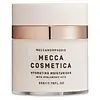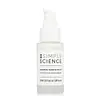What's inside
What's inside
 Key Ingredients
Key Ingredients

 Benefits
Benefits

 Concerns
Concerns

 Ingredients Side-by-side
Ingredients Side-by-side

Water
Skin ConditioningC12-15 Alkyl Benzoate
AntimicrobialGlycerin
HumectantCaprylic/Capric Triglyceride
MaskingMyristyl Myristate
EmollientCetearyl Alcohol
EmollientCetyl Alcohol
EmollientStearic Acid
CleansingDimethicone
EmollientButyrospermum Parkii Butter
Skin ConditioningGlyceryl Stearate
EmollientCeteareth-20
CleansingSodium Acrylate/Sodium Acryloyldimethyl Taurate Copolymer
Emulsion StabilisingPhenoxyethanol
PreservativeTocopheryl Acetate
AntioxidantIsohexadecane
EmollientCaprylyl Glycol
EmollientPentylene Glycol
Skin ConditioningXanthan Gum
EmulsifyingEthylhexylglycerin
Skin ConditioningParfum
MaskingPolysorbate 80
EmulsifyingHydrolyzed Rice Protein
Skin ConditioningFructose
HumectantUrea
BufferingCitric Acid
BufferingSodium Hydroxide
BufferingHydrolyzed Pea Protein
EmollientMaltose
MaskingSodium PCA
HumectantSodium Chloride
MaskingSodium Lactate
BufferingTrehalose
HumectantAllantoin
Skin ConditioningGlycine
BufferingProline
Skin ConditioningHydrolyzed Sodium Hyaluronate
Skin ConditioningDisodium EDTA
Sodium Hyaluronate
HumectantGlucose
HumectantWater, C12-15 Alkyl Benzoate, Glycerin, Caprylic/Capric Triglyceride, Myristyl Myristate, Cetearyl Alcohol, Cetyl Alcohol, Stearic Acid, Dimethicone, Butyrospermum Parkii Butter, Glyceryl Stearate, Ceteareth-20, Sodium Acrylate/Sodium Acryloyldimethyl Taurate Copolymer, Phenoxyethanol, Tocopheryl Acetate, Isohexadecane, Caprylyl Glycol, Pentylene Glycol, Xanthan Gum, Ethylhexylglycerin, Parfum, Polysorbate 80, Hydrolyzed Rice Protein, Fructose, Urea, Citric Acid, Sodium Hydroxide, Hydrolyzed Pea Protein, Maltose, Sodium PCA, Sodium Chloride, Sodium Lactate, Trehalose, Allantoin, Glycine, Proline, Hydrolyzed Sodium Hyaluronate, Disodium EDTA, Sodium Hyaluronate, Glucose
Water
Skin ConditioningCalophyllum Inophyllum Seed Oil
AntimicrobialCaprylic/Capric Triglyceride
MaskingC12-15 Alkyl Benzoate
AntimicrobialGlyceryl Stearate
EmollientCetearyl Alcohol
EmollientMethyl Glucose Sesquistearate
EmollientUrea
BufferingPropanediol
SolventGlycerin
HumectantSodium Hyaluronate
HumectantDimethicone
EmollientSaccharide Isomerate
HumectantSodium Phosphate
BufferingGlyceryl Caprylate
EmollientSodium PCA
HumectantOleyl Alcohol
EmollientGlycine Soja Sterols
EmollientTocopherol
AntioxidantLactic Acid
BufferingBetaine
HumectantSorbitol
HumectantSerine
MaskingGlycine
BufferingGlutamic Acid
HumectantAlanine
MaskingArginine
MaskingThreonine
Manganese PCA
HumectantProline
Skin ConditioningCeteareth-25
CleansingCetyl Alcohol
EmollientMagnesium PCA
HumectantDisodium Phosphate
BufferingCeramide EOP
Skin ConditioningZinc PCA
HumectantCeramide Eos
Skin ConditioningPotassium Lactate
BufferingCeramide NP
Skin ConditioningLysine
Skin ConditioningCeramide Ns
Skin ConditioningDioscorea Villosa Root Extract
Skin ConditioningCeramide AP
Skin ConditioningCaprooyl Phytosphingosine
Skin ConditioningCaprooyl Sphingosine
Skin ConditioningHydroxyacetophenone
AntioxidantBehenic Acid
CleansingCholesterol
EmollientXanthan Gum
EmulsifyingWater, Calophyllum Inophyllum Seed Oil, Caprylic/Capric Triglyceride, C12-15 Alkyl Benzoate, Glyceryl Stearate, Cetearyl Alcohol, Methyl Glucose Sesquistearate, Urea, Propanediol, Glycerin, Sodium Hyaluronate, Dimethicone, Saccharide Isomerate, Sodium Phosphate, Glyceryl Caprylate, Sodium PCA, Oleyl Alcohol, Glycine Soja Sterols, Tocopherol, Lactic Acid, Betaine, Sorbitol, Serine, Glycine, Glutamic Acid, Alanine, Arginine, Threonine, Manganese PCA, Proline, Ceteareth-25, Cetyl Alcohol, Magnesium PCA, Disodium Phosphate, Ceramide EOP, Zinc PCA, Ceramide Eos, Potassium Lactate, Ceramide NP, Lysine, Ceramide Ns, Dioscorea Villosa Root Extract, Ceramide AP, Caprooyl Phytosphingosine, Caprooyl Sphingosine, Hydroxyacetophenone, Behenic Acid, Cholesterol, Xanthan Gum
 Reviews
Reviews

Ingredients Explained
These ingredients are found in both products.
Ingredients higher up in an ingredient list are typically present in a larger amount.
C12-15 Alkyl Benzoate is made up of Benzoic Acid and long chain alcohols. It has a low molecular weight.
C12-15 Alkyl Benzoate is an emollient and texture enhancer. Due to its solubility, it is often used in sunscreens to help evenly distribute active ingredients.
As an emollient, C12-15 Alkyl Benzoate helps soften and hydrate your skin. Emollients create a film on your skin that traps moisture within.
This ingredient has been reported to cause eye irritation.
Learn more about C12-15 Alkyl BenzoateThis ingredient is an emollient, solvent, and texture enhancer. It is considered a skin-softener by helping the skin prevent moisture loss.
It helps thicken a product's formula and makes it easier to spread by dissolving clumping compounds.
Caprylic Triglyceride is made by combining glycerin with coconut oil, forming a clear liquid.
While there is an assumption Caprylic Triglyceride can clog pores due to it being derived from coconut oil, there is no research supporting this.
Learn more about Caprylic/Capric TriglycerideCetearyl alcohol is a mixture of two fatty alcohols: cetyl alcohol and stearyl alcohol. It is mainly used as an emulsifier. Emulsifiers help prevent the separation of oils and products. Due to its composition, it can also be used to thicken a product or help create foam.
Cetearyl alcohol is an emollient. Emollients help soothe and hydrate the skin by trapping moisture.
Studies show Cetearyl alcohol is non-toxic and non-irritating. The FDA allows products labeled "alcohol-free" to have fatty alcohols.
This ingredient is usually derived from plant oils such as palm, vegetable, or coconut oils. There is debate on whether this ingredient will cause acne.
Due to the fatty acid base, this ingredient may not be Malassezia folliculitis safe.
Learn more about Cetearyl AlcoholCetyl Alcohol is a fatty alcohol. Fatty Alcohols are most often used as an emollient or to thicken a product.
Its main roles are:
Though it has "alcohol" in the name, it is not related to denatured alcohol or ethyl alcohol.
The FDA allows products labeled "alcohol-free" to have fatty alcohols.
Learn more about Cetyl AlcoholDimethicone is a type of synthetic silicone created from natural materials such as quartz.
What it does:
Dimethicone comes in different viscosities:
Depending on the viscosity, dimethicone has different properties.
Ingredients lists don't always show which type is used, so we recommend reaching out to the brand if you have questions about the viscosity.
This ingredient is unlikely to cause irritation because it does not get absorbed into skin. However, people with silicone allergies should be careful about using this ingredient.
Note: Dimethicone may contribute to pilling. This is because it is not oil or water soluble, so pilling may occur when layered with products. When mixed with heavy oils in a formula, the outcome is also quite greasy.
Learn more about DimethiconeGlycerin is already naturally found in your skin. It helps moisturize and protect your skin.
A study from 2016 found glycerin to be more effective as a humectant than AHAs and hyaluronic acid.
As a humectant, it helps the skin stay hydrated by pulling moisture to your skin. The low molecular weight of glycerin allows it to pull moisture into the deeper layers of your skin.
Hydrated skin improves your skin barrier; Your skin barrier helps protect against irritants and bacteria.
Glycerin has also been found to have antimicrobial and antiviral properties. Due to these properties, glycerin is often used in wound and burn treatments.
In cosmetics, glycerin is usually derived from plants such as soybean or palm. However, it can also be sourced from animals, such as tallow or animal fat.
This ingredient is organic, colorless, odorless, and non-toxic.
Glycerin is the name for this ingredient in American English. British English uses Glycerol/Glycerine.
Learn more about GlycerinGlyceryl Stearate is a mix of glycerin and stearic acid.
It is used to stabilize the mixing of water and oil ingredients. By preventing these ingredients from separating, it can help elongate shelf life. It can also help thicken the product's texture.
As an emollient, it helps soften skin and supports barrier-replenishing ingredients.
In cosmetics, Glyceryl Stearate is often made from vegetable oils or synthetically produced.
This ingredient may not be fungal-acne safe
Fun fact: The human body also creates Glyceryl Stearate naturally.
Learn more about Glyceryl StearateThis ingredient is an amino acid that helps build proteins and moisturizes skin. It is already present in our skin as our bodies produce them naturally.
Glycine already plays a role in helping keep our skin moisturized as amino acids transport moisture throughout our skin.
As collagen is made up of glycine and other amino acids, it is believed glycine may help our skin produce more collagen.
Learn more about GlycineProline is an amino-acid. It helps moisturize the skin and plays an important role in creating proteins.
Our skin uses proline as one of the building blocks for producing collagen.
In medicine, proline is used as an osmoprotectant. This means it helps prevent oxidative degradation in other drugs.
Our bodies are able to produce proline naturally, but certain conditions may inhibit this production. In that case, proline can be obtained from eating egg whites, soy protein, dairy products, asparagus, mushrooms, and seaweed.
Learn more about ProlineSodium Hyaluronate is hyaluronic acid's salt form. It is commonly derived from the sodium salt of hyaluronic acid.
Like hyaluronic acid, it is great at holding water and acts as a humectant. This makes it a great skin hydrating ingredient.
Sodium Hyaluronate is naturally occurring in our bodies and is mostly found in eye fluid and joints.
These are some other common types of Hyaluronic Acid:
Learn more about Sodium HyaluronateSodium PCA is the sodium salt of pyroglutamic acid. It is naturally occurring in our skin's natural moisturizing factors where it works to maintain hydration.
The PCA stands for pyrrolidone carboxylic acid, a natural amino acid derivative.
This ingredient has skin conditioning, anti-inflammatory, and humectant properties. Humectants help hydrate your skin by drawing moisture from the air. This helps keep your skin moisturized.
Learn more about Sodium PCAUrea is also called carbamide and is the diamide of carbonic acid. In cosmetics, urea is used to hydrate the skin. It also provides exfoliation in higher concentrations.
As a humectant, urea helps draw moisture from the air and from deep within the skin. This helps hydrate your skin. Studies show urea is an effective moisturizer for dry skin conditions. 40% urea is typical in medications for treating eczema and other skin conditions.
Urea has the strongest exfoliation effect in concentrations higher than 10%. It is a keratolytic agent, meaning it breaks down the keratin protein in the top layer of skin. This helps remove dead skin cells and flaking skin.
In medicine, urea has been shown to help increase the potency of other ingredients, such as fungal treatments.
Humans and animals use urea to metabolize nitrogen-containing compounds. Urea is highly soluble in water. Once dissolved, it is neither acidic nor alkaline.
Learn more about UreaWater. It's the most common cosmetic ingredient of all. You'll usually see it at the top of ingredient lists, meaning that it makes up the largest part of the product.
So why is it so popular? Water most often acts as a solvent - this means that it helps dissolve other ingredients into the formulation.
You'll also recognize water as that liquid we all need to stay alive. If you see this, drink a glass of water. Stay hydrated!
Learn more about WaterXanthan gum is used as a stabilizer and thickener within cosmetic products. It helps give products a sticky, thick feeling - preventing them from being too runny.
On the technical side of things, xanthan gum is a polysaccharide - a combination consisting of multiple sugar molecules bonded together.
Xanthan gum is a pretty common and great ingredient. It is a natural, non-toxic, non-irritating ingredient that is also commonly used in food products.
Learn more about Xanthan Gum